Emison Galleries
Viewpoints and Attitudes: Asian Art and the Western World Exhibition
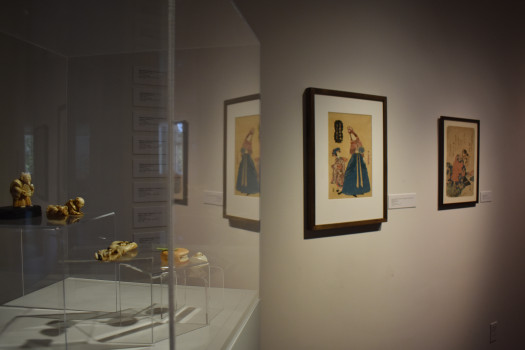
Viewpoints and Attitudes: Asian Art and the Western World Exhibition
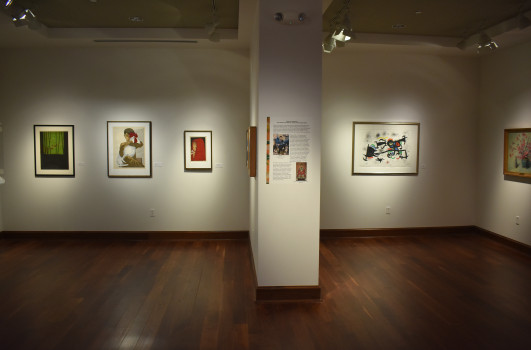
Shidzuo Iikubo '23 Gallery of Asian Art
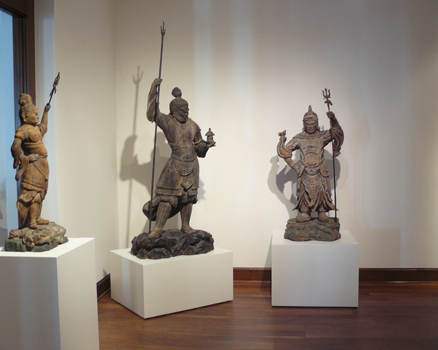
Shidzuo Iikubo '23 Gallery of Asian Art

Emison Building Galleries and Directions
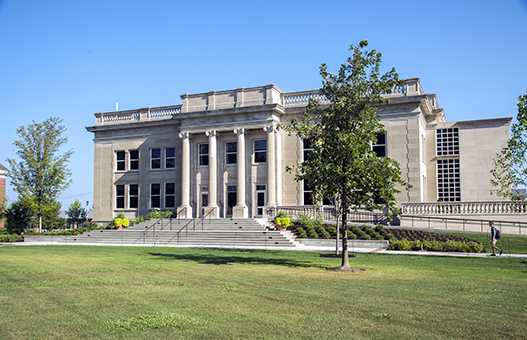
The Emison Building (Office of Admission) is located on the campus of DePauw University, at 204 East Seminary Street in Greencastle, Indiana. Visitor parking is located next to the building and along Seminary Street. Please click here for further directions.
About Shidzuo Iikubo '23 Asian Art Gallery
Shidzuo Iikubo '23 Asian Art Gallery
In 1991, DePauw received the Arthur E. Klauser '45 Asian and World Community Collection. The gift included Buddhist art, notably icons and mandalas, objects related to Japanese noh theater and samurai culture, painted screens, and woodblock prints from the 18th and 19th centuries. Selected objects from this collection are currently displayed in the Shidzuo Iikubo Gallery, a dedicated exhibition space for Asian art. The gallery was generously funded by Hirotsugu "Chuck" Iikubo '57 in honor of his father, Shidzuo Iikubo, a graduate of the Class of 1923.
Gifts of Tibetan art donated by Bruce Walker ’53 complement the Asian collection and include an impressive number of 18th-20th century thangka paintings, 20th century drawings, and religious and ceremonial objects. Highlights from this collection are also on display in the Shidzuo Iikubo Gallery. New labels were added to the gallery in 2013 by students enrolled in a Winter Term course.
Additionally, we've teamed up with Culture Spots to bring audio to the gallery spaces for our visitors to enjoy. Completely free and with no separate app required, you can even listen to our audio tours OUTSIDE of the gallery space!
Emison Gallery
Viewpoints and Attitudes: Asian Art and the Western World is an invitation to consider how artists represent their culture, and the impact of other cultures, in their art. This exhibit explores the viewpoints and attitudes artists reveal about themselves and how they are influenced to imagine people on the other side of the world.
Viewpoints and Attitudes was researched and curated by the 2021-2022 Arthur E. Klauser Fellow, Caleigh Ranjo ‘21. This exhibition builds on her scholarly interests in material culture, cultural exchange and relations between Asia and the Western World.
DePauw alumni who have donated their art collections and objects to the Peeler Galleries made this exhibit possible. With their generosity and underwriting, the long tradition of cultural exchange at DePauw continues.
Iikubo Gallery: Donors
Students enrolled in the winter term course, Introduction to Museum Studies, wrote new interpretive labels and created this website content in 2013. Prior to their work, the exhibition lacked interpretive texts and contextual information. This virtual website is an extension of their gallery work. Site content created by: Caitlin Qua '16, Jamie Oriez '16, Leigh Plummer '16, and Michael Paniccia '14.
On behalf of the DePauw University gallery staff, I would like to acknowledge the generous donations of three major donors to the display and presentation of Asian art at the Emison building:
Thanks to their support, DePauw University is able to provide students, faculty, and visitors with the opportunity to study first-rate works of Chinese, Japanese, and Tibetan art without leaving Greencastle. We are forever grateful for the invaluable gifts they've entrusted to DePauw and our future alumni. I hope you enjoy this virtual exhibition assembled by DePauw students in 2013 as part of a winter term course assignment. The students enjoyed working in the galleries so much that they voluntarily created this website content and an audio tour as well.
We hope to see you in the Emison galleries soon.
Sincerely,
Craig Hadley
Former Director/Curator
Gallery Dedication
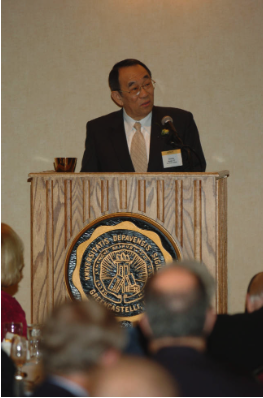
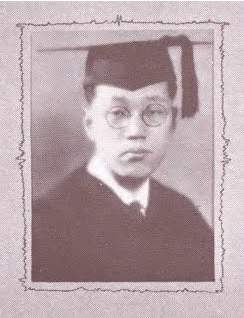
Recognizing the gift of Hirotsugu "Chuck" Iikubo '57 (above left) honoring his father, Shidzuo Iikubo (above right), a graduate of the Class of 1923. Mr. Iikubo's generosity was also honored at the dedication of the Emison Museum on October 29, 2005. 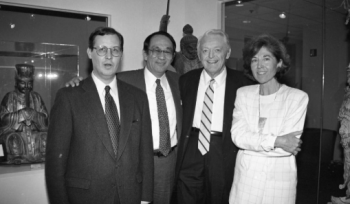
Left to right: Paul B. Watt (Asian Studies Faculty); Hirotsugu "Chuck" Iikubo '57; Arthur E. Klauser '45; Martha B. Opdahl (Curator of University Collections). Photograph from 1994 Asian Studies lecture and Iikubo Gallery dedication.
Iikubo Gallery: Buddhist Art
A Brief History
Buddhism was founded by Siddhartha Gautama, also known as the Buddha or “Enlightened One”, who lived from 566 to 480 B.C. Gautama was born into the family of a wealthy warrior-king and lived an extravagant life. As he bored of royal life, he decided to wander the world in search of understanding and renounced his title to become a monk. One day while meditating beneath a tree, Gautama finally understood how to be free from suffering and achieve salvation. He then dedicated his life to spread his understandings throughout India.
Four Noble Truths
The Four Noble Truths are the core of the Buddha’s teachings. The First Noble Truth is the truth of suffering, or the truth that suffering exists. The Second Noble Truth is the truth of the cause of suffering. In Buddhism, desire and ignorance lie at the root of suffering. Vices, such as greed, envy, hatred, and anger derive from both desire and ignorance. The Third Noble Truth states that there is an end to suffering through achieving Nirvana, a transcendent state free from suffering and the worldly cycle of birth and rebirth. The fourth and final truth lays down the path to attaining the end of suffering, known as the Noble Eightfold Path. The steps of the Eightfold Path are Right Understanding, Right Thought, Right Speech, Right Action, Right Livelihood, Right Effort, Right Mindfulness, and Right Concentration.
Karma
In Buddhism, Karma refers to the good or bad actions a person takes during their lifetime. Good actions bring about happiness in the long run and bad actions bring about unhappiness in the long run. There is also neutral karma, which derives from acts such as breathing, eating, and sleeping, and has no benefits or costs. The karma weight that certain actions carry is determined by their frequency, intentionality, and if they are performed without regret, against extraordinary persons, or towards someone who has helped in the past. Karma is a main factor in the Buddhist cycle of rebirth, as it determines the realm into which living things can be reborn.
The Cycle of Rebirth
There are six planes into which living beings can be reborn. Those with positive karma are reborn into one of the three fortunate realms: the realms of demigods, gods, and men. Those with negative karma are reborn into the realms of animals, ghosts, and hell. The realm of man is considered the highest realm of rebirth because they are free from relentless conflict and suffer less suffering than all other realms. Also, men have the opportunity to achieve Nirvana, something that the other realms lack.
Buddha Imagery Interactive
Images of Buddha can be found throughout this art collection, and may look very similar. The most common type of image shows the Buddha in a lotus position during meditation, which represents both the importance of meditation in his life and the moment of his Enlightenment. His eyes are closed, the soles of his feet visible, and his hands rest in his lap (the Dyhana Mudra). To find out more about the different ways Buddha is depicted, click the link below.
Source:
PBS The Living Edens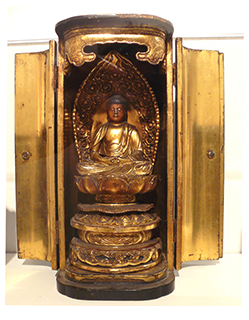
Butsudan (private Buddhist altarpiece)
Japanese, c. 16th century
carved and gilded wood
Gift of OGATA Sennosuke, 1885.1.1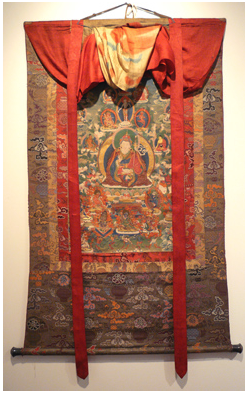
Padmasambhava Thangka
Tibetan, 19th century
ground mineral pigment on cotton and silk
Gift of Bruce Walker '53, 2002.4.2
Padmasambhava, also known as Guru rinpoche (Precious Teacher), was the adept Indian yogi from the present regions of northern Pakistan and Afghanistan who brought Buddhism to Tibet in the 8th Century. Regarded as the spiritual father of Tibetan Buddhism and founder of the Nyingma Sect, Padmasambhava is credited with "taming" and incorporating the many indigenous deities (Tsug), demons and spirits that are linked with animistic elements of Tibet's landscape into the Buddhist pantheon. Invited to Tibet by the 8th Century King, Tri Song Detsen, Padmasambhava in renowned for subduing negative energies and political obstacles that were preventing the construction of Samye, Tibet's first Buddhist monastery.
The Shitennō, Guardian Kings of the Four Directions
Known as the Four Heavenly Kings, these figures are positioned at the four corners of Japanese Buddhist altars, each watching over a different cardinal direction. As deities, they protect from evil spirits – psychological states that go against the Buddha and his message of freedom from suffering. The examples displayed here were likely intended for the altar of a smaller worship space, rather than that of a large temple. The Shitennō are usually portrayed dressed in armor, carrying symbolic weapons or objects, and standing on a demonic figure - signifying their dominance over enemies of Buddhism.
Not on display: Jikoku-ten, Guardian of the East
Bishamon-ten, Guardian King of the North
Known as Bishamon-ten in Japan, where he is the only Shitennō worshipped individually, Tamon-ten is the omniscient leader of the Shitennō and the most powerful of them. As the protector of Buddhism and its faithful, he is the patron of warriors, the punisher of evil-doers, and one of Japan’s Seven Lucky Gods – the bringer of wealth and prosperity. He is portrayed here holding a trident - symbolizing triumph over ignorance - and a miniature stupa (a structure that houses religious relics), representing Buddhist thought and the treasures of Buddha’s teachings, which Bishamon-ten both protects and dispenses to the worthy.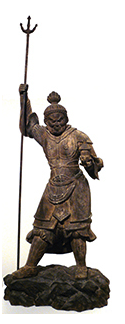
Bishamon-ten, Guardian King of the North
Japanese, 1420-1500 C.E.
carved wood with traces of pigment
Gift of Arthur E. Klauser '45, 1991.11.140a-b
Iikubo Gallery: Warrior Art
The Japanese warrior is a symbol of strength, dignity, and power -- ideals reflected in warrior art. Warrior art also draws attention to traditional Japanese values such as beauty and frugality, bringing together both aesthetics and functionality.
Japanese armor emphasized both function and form. The leather, polished wood, metal, and colored cording combine to create an aesthetically pleasing covering and strong, comparatively lightweight protection perfect for hand-to-hand combat. Worn primarily for protection, face masks also reflected an artistic purpose through the depiction of characters such as monkeys and goblins, as well as more human appearances.
This scroll, as a set of instructions, indicates the importance of order, long-standing tradition and ritual practice in Japanese society. A warrior donned his armor in a specific order expressing, in the process, courage and respect.
Ukiyo-e (pictures of the floating world) became popular in the 17th century as art for townspeople, since it was inexpensive. This print pictures a famous battle from the 12th century, a popular motif during the unstable time of the 1800s.
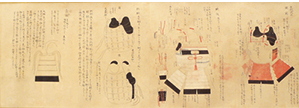
Handscroll: Treatise on Japanese Samurai Armor
Japanese, 19th century
ink on paper
Gift of Arthur E. Klauser '45, 1991.11.252
Samurai Battle
Japanese, 19th century
color woodblock print (ukiyo-e)
Gift of Arthur E. Klauser '45, 1991.11.240 a-c
This triptych represents a famous battle of 1185 -- The Night Attack on the Rokujo Horikawa Mansion -- at the end of the Heian period. Cartouches identify each of the samurai engaged in battle.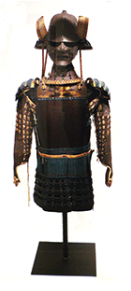
Suit of Samurai Armor
Japanese, Ashikaga Period (1338 – 1573 C.E.)
fabric, metal and mixed media
Gift of Arthur E. Klauser '45, 1991.11.159

